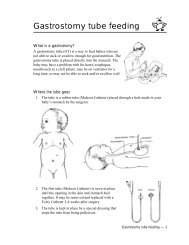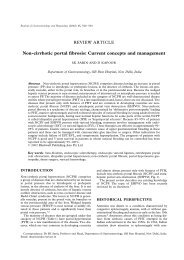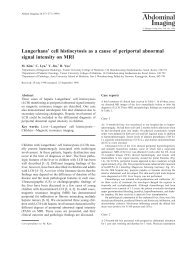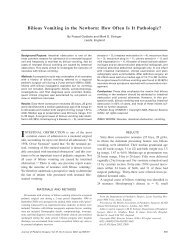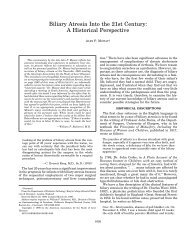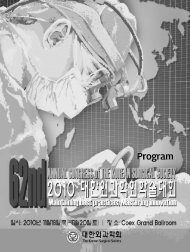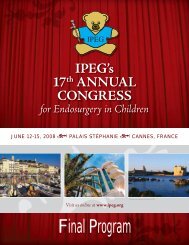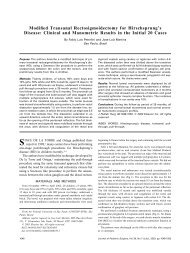Choledochal Cysts: Age of Presentation, Symptoms ... - ResearchGate
Choledochal Cysts: Age of Presentation, Symptoms ... - ResearchGate
Choledochal Cysts: Age of Presentation, Symptoms ... - ResearchGate
You also want an ePaper? Increase the reach of your titles
YUMPU automatically turns print PDFs into web optimized ePapers that Google loves.
<strong>Choledochal</strong> <strong>Cysts</strong>: <strong>Age</strong> <strong>of</strong> <strong>Presentation</strong>, <strong>Symptoms</strong>, and LateComplications Related to Todani’s ClassificationBy J.S. de Vries, S. de Vries, D.C. Aronson, D.K. Bosman, E.A.J. Rauws, A. Bosma, H.A. Heij, D.J. Gouma, andT.M. van GulikAmsterdam, The NetherlandsPurpose: The aim <strong>of</strong> this study was to compare presentation,complications, diagnosis, and treatment <strong>of</strong> choledochal cystsin pediatric and adult patients.Methods: Forty-two patients were analyzed after subdivisioninto 3 groups: group A, less than 2 years (n 10); group B, 2to 16 years (n 11); group C, greater than 16 years (n 21).Results: The cysts were classified as extrahepatic (n 33),intrahepatic (n 5), and combined (n 4). Seventy-sixpercent <strong>of</strong> patients presented with abdominal pain, (20 <strong>of</strong> 21group C), and 57% with jaundice, (10 <strong>of</strong> 10 group A). Cholangiocarcinomaoccurred in 6 patients, 4 <strong>of</strong> whom had previouslyundergone internal drainage procedures. Excision <strong>of</strong>the extrahepatic cyst was performed in 27 <strong>of</strong> 37 patients. Fivepatients, <strong>of</strong> whom, 4 had cholangiocarcinoma, were beyondcurative treatment at the time <strong>of</strong> diagnosis. Six patients haddied at the closure <strong>of</strong> this study, 5 <strong>of</strong> them had carcinoma.Conclusions: Presenting symptoms are age dependent withjaundice prevailing in children and abdominal pain in adults.In view <strong>of</strong> the high risk <strong>of</strong> cholangiocarcinoma, early resectionand not internal drainage is the appropriate treatment <strong>of</strong>extrahepatic cysts. Patients who had undergone internaldrainage in the past still should undergo resection <strong>of</strong> thecyst.J Pediatr Surg 37:1568-1573. Copyright 2002, Elsevier Science(USA). All rights reserved.INDEX WORDS: <strong>Choledochal</strong> cyst, cholangiocarcinoma.CHOLEDOCHAL CYST is a rare congenital dilatation<strong>of</strong> the bile ducts. The estimated incidence inWestern countries varies between 1 in 100,000 and 1 in150,000. 1 The incidence is higher in Asia and occursmore in women, with a male to female ratio <strong>of</strong> 1:3 to 4. 1,2The most widely used subdivision <strong>of</strong> choledochalcysts is Todani’s classification (Fig 1), which is a modification<strong>of</strong> the Alonso-Lej classification. 3 Type I cystsare the most frequently encountered. The intrahepaticpart <strong>of</strong> type IVa and type V cysts occur diffusely or in apart <strong>of</strong> the liver. Not shown in this figure is type IVb,featuring multiple extrahepatic dilatations, which is avery uncommon condition.<strong>Choledochal</strong> cysts belong to the fibropolycystic disorders.4,5 Type V (Caroli’s disease) and probably the intrahepaticpart <strong>of</strong> type IVa cysts are thought to be ductalplate malformations (DPM). 4 The precise etiology <strong>of</strong>extrahepatic cysts is unclear. Type I cysts are associatedwith an abnormal arrangement <strong>of</strong> the pancreatobilliaryFrom the Departments <strong>of</strong> Surgery, Pediatric Surgery, PediatricGastroenterology, Gastroenterology, and Pathology, Academic MedicalCenter and Vrije Universiteit Medical Center, Amsterdam, TheNetherlands.Address reprint requests to T.M. van Gulik, Chirurgisch Laboratorium,Meibergdreef 9, 1105 AZ Amsterdam, The Netherlands.Copyright 2002, Elsevier Science (USA). All rights reserved.0022-3468/02/3711-0011$35.00/0doi:10.1053/jpsu.2002.36186ducts (APBD), also known as “common channel,” whichis seen in up to 92% <strong>of</strong> the patients 2,6 with choledochalcysts. A long common channel (2 cm) can be the cause<strong>of</strong> a variety <strong>of</strong> pathologic conditions, 6 such as pancreatitis,stenosis <strong>of</strong> the papilla <strong>of</strong> Vater, and choledochal cysts(Fig 2). Although a common channel may occur withouta choledochal cyst, 7 an APBD is believed to enhancereflux <strong>of</strong> pancreatic juice into the bile duct, leading toexposure <strong>of</strong> the common bile duct wall to pancreaticenzymes and to higher pressures in the choledochal ductfinally resulting in cyst formation. 2If choledochal cysts are not resected, a high incidence(20% to 30%) <strong>of</strong> cholangiocarcinoma has been reported,mainly after the second decade <strong>of</strong> life, 8 which formed thebasis <strong>of</strong> resection as state <strong>of</strong> the art surgical treatment.This policy is further supported by a study that foundincreasing rate <strong>of</strong> premalignant changes in resected cystswith advancing age. 6The aim <strong>of</strong> this study was to evaluate the difference inpresentation, complications, diagnosis, and treatment <strong>of</strong>choledochal cysts in children and adults in 2 academiccenters.PatientsMATERIALS AND METHODSBetween 1972 and 2000, 42 patients with choledochal cysts weretreated in the Academic Medical Center (n 36) or the AcademicHospital <strong>of</strong> the Vrije Universiteit Medical Center (n 6), Amsterdam,1568 Journal <strong>of</strong> Pediatric Surgery, Vol 37, No 11 (November), 2002: pp 1568-1573
CHOLEDOCHAL CYSTS1569Table 1. <strong>Symptoms</strong> and <strong>Age</strong><strong>Symptoms</strong>Total(n 42)Group A(n 10)Group B(n 11)Group C(n 21)Abdominal pain 32 3 9 20Jaundice 24 10 8 6Nausea/vomiting 19 4 8 7Hepatomegaly 14 9 4 1Weight loss/failure to thrive 10 4 2 4Palpable mass 7 3 2 2Portal hypertension 1 0 1 0Sepsis 1 0 0 1Cholangitis 15 2 6 7Pancreatitis 7 1 4 2Gallstones 10 2 2 6Fig 1. Classification <strong>of</strong> choledochal cysts according to Todani,with relative incidences. 1,2 I, Type I: Dilatation <strong>of</strong> hepatic and commonbile duct (40% to 85%); II, Type II: Diverticulum <strong>of</strong> the commonbile duct (2% to 3%); III, Type III: Intraduodenal common bile ductdilatation (1.4% to 5.6%); IVa, Type IVa: Intra- and extrahepatic bileduct dilatation (18% to 20%); V, Type V: Intrathepatic bile ductdilatation (rare).the Netherlands. The median age was 16 years (range, 0 to 72 years);the male to female ratio was 1:3.MethodsThe study was designed as a case-cohort report. Data were collectedusing patients’ files, operative reports, and <strong>of</strong>fice notes. The followingFig 2. ERCP image <strong>of</strong> a common channel. The arrow starts at theconfluence <strong>of</strong> the pancreatic duct and the common bile duct (<strong>of</strong>which only a small part is visible), pointing toward the duodenalpapilla.data were collected: presenting symptoms, complications <strong>of</strong> the disease,diagnostic strategy, and treatment <strong>of</strong> choledochal cysts. Patientswere subdivided into 3 age groups: group A, patients below 2 years <strong>of</strong>age; group B, patients from 2 to 16 years; and group C, patients olderthan 16 years. Statistical significance <strong>of</strong> the results was evaluated usingthe 2 test, with a P .05 as the level <strong>of</strong> significance. Significance ismentioned in text and tables when relevant. In general, the P value wascalculated from the value <strong>of</strong> a parameter in a group or categorycompared with the expected value based on the total <strong>of</strong> the parameterin all patients.RESULTSClinical <strong>Presentation</strong>Table 1 shows the presenting symptoms with subdivisioninto the age groups. Abdominal pain is the mostfrequent symptom (32 <strong>of</strong> 42 patients (76%) at presentation,with a significantly higher incidence in the adultgroup (20 <strong>of</strong> 21 patients; P .05). Jaundice is the mainpresenting symptom in children and was seen in all 10patients below 2 years <strong>of</strong> age, resulting in a significantlyhigher incidence (P .05) in this age group. Overall, wefound cholangitis (cholestasis in combination with fever)in more than one third <strong>of</strong> the patients (15 <strong>of</strong> 42 patients(36%). Pancreatitis was present in only 7 <strong>of</strong> 42 patients(17%). Although not significant, it was most frequentlyseen in the age group between 2 and 16 years (4 <strong>of</strong> 11patients, 36%).Table 2 shows the presenting symptoms comparedwith the type <strong>of</strong> cyst. Abdominal pain is the mainsymptom in most types. Jaundice is mainly seen in typeI (17 <strong>of</strong> 30 patients; P .05) and IV (4 <strong>of</strong> 4 patients; P .05) cysts, both (partly) extrahepatic. Exclusively intrahepaticcysts (type V) present primarily with bothcholangitis (4 <strong>of</strong> 5 patients; P .05) and gall stones (4<strong>of</strong> 5 patients; P .05).The classic triad, which consists <strong>of</strong> abdominal pain,jaundice, and a palpable mass, was seen in only 2patients.Diagnostic ProceduresThe following studies were performed: ultrasoundscan (39 <strong>of</strong> 42 patients [93%]), ERCP (29 <strong>of</strong> 42 patients
1570 DE VRIES ET ALTable 2. <strong>Presentation</strong> and Cyst TypeI(n 30)II(n 2)Cyst TypeIII(n 1)IV(n 4)V(n 5)Total(n 42)Abdominalpain 21 1 1 4 5 32Jaundice 17 1 0 4 2 24Vomiting 17 0 0 1 1 19Hepatomegaly 11 1 0 1 1 14Weight loss 8 1 0 0 1 10Palpable mass 7 0 0 0 0 7Portalhypertension 1 0 0 0 0 1Sepsis 0 0 0 1 0 1Cholangitis 8 1 0 2 4* 15Pancreatitis 6 0 0 1 0 7Gallstones 4* 0 0 2 4* 10*P .05.[69%], Fig 2), PTC (3 <strong>of</strong> 42 patients [7%]), MRCP (1 <strong>of</strong>42 patients [2%], Fig 3), abdominal computed tomographyscan (10 <strong>of</strong> 42 patients [24%]), abdominal x-ray (3<strong>of</strong> 42 patients [7%]), laparoscopy (2 <strong>of</strong> 42 patients [5%]),gastroduodenoscopy (2 <strong>of</strong> 42 patients [5%]), and biopsy(2 <strong>of</strong> 42 patients [5%] one biopsy <strong>of</strong> the duodenal papillaat ERCP and one percutaneous <strong>of</strong> the liver, both positivefor [metastatic] cancer). Laboratory studies, like serumamylase, were not systematically performed. ERCP wasused less frequently in younger than in older patients:group A, 5 <strong>of</strong> 10 patients (50%); group B, 5 <strong>of</strong> 11patients (45%); group C, 20 <strong>of</strong> 21 (95%).DiagnosisTable 3 shows the types <strong>of</strong> cysts among the studygroup. The majority <strong>of</strong> the cysts were extrahepatic,mostly type I cysts: 30 <strong>of</strong> 42 patients (71%). There wereno type IVb cysts. Type V cysts (5 <strong>of</strong> 42 patients [12%]),were seen only in the adult group. Three <strong>of</strong> 5 <strong>of</strong> type Vcysts were diffusely intrahepatic, and 2 <strong>of</strong> 5 were confinedto the left lobe <strong>of</strong> the liver.Extrahepatic cholangiocarcinoma was encountered in6 <strong>of</strong> 42 patients, all group C (5 with type I and I with typeIVa cysts) and one in combination with liver metastases.In only 29 <strong>of</strong> 42 <strong>of</strong> the patients an ERCP or PTC wasavailable on which the presence <strong>of</strong> a common channelcould be assessed. A common channel was seen in 10 <strong>of</strong>DiagnosisTable 3. DiagnosisTotal(n 42)Group A(n 10)Group B(n 11)Group C(n 21)Type I 30 9 9 12Type II 2 0 1 1Type III 1 0 0 1Type IVa 4 1 1 2Type V 5 0 0 5Common channel 10 3 2 5Carcinoma 6 0 0 6Fig 3. MRCP image <strong>of</strong> a choledochal cyst, type 1.29 <strong>of</strong> these patients. In 1 <strong>of</strong> these 10 patients a cholangiocarcinomapresented in conjunction with a commonchannel. All other patients with carcinoma did not havea common channel, although in 4 patients this wasdifficult to judge because <strong>of</strong> earlier internal drainageprocedures.Interval Between First <strong>Presentation</strong> and (Attempted)ResectionIn 14 <strong>of</strong> 42 patients (33%) the interval between firstpresentation and (attempted) resection was more thenone year (range, 2 to 33 years; mean, 14 years). In 7 <strong>of</strong>14 patients, this was because <strong>of</strong> a late diagnosis, and in5 <strong>of</strong> 14 patients, initially an internal drainage procedurehad been performed. In 2 <strong>of</strong> 14 patients (both group B)there was both a late diagnosis and an earlier internaldrainage procedure. A long interval was most frequentlyseen in group C (9 <strong>of</strong> 21, 43%).Four <strong>of</strong> the patients with carcinoma belonged to the 14patients with an interval longer than one year. In onepatient, the choledochal cyst was first thought to be apancreatic pseudocyst, which was treated by marsupialisation;3 patients were treated initially with a cystenterostomy.TreatmentMost patients underwent a resection, as shown inTable 4. This consisted <strong>of</strong> resection <strong>of</strong> the extrahepaticcyst (type I, II and the extrahepatic part <strong>of</strong> type IVa) withreconstruction <strong>of</strong> a biliary digestive anastomosis by aRoux-Y loop in the majority <strong>of</strong> the patients. Three
1572 DE VRIES ET ALTable 5. Incidence <strong>of</strong> Malignancy in <strong>Choledochal</strong> <strong>Cysts</strong> Reported in LiteratureStudy, YearNo. <strong>of</strong>PatientsNo. <strong>of</strong> Patients WithMalignancies (%)Malignancies AfterInternal Drainage(% <strong>of</strong> All Malignancies)<strong>Age</strong> at<strong>Presentation</strong> <strong>of</strong>MalignancyJan et al, 20 2000 80 8 (10) 3 (38) 50 (32-81)Bismuth and Krissat, 21 1999 48 6 (13) 2 (33) 39 (17-57)Lenriot et al, 22 1998 42 5 (12) 3 (60) 39 (29-51)Hewitt et al, 13 1995 14 2 (14) 0 (0) 46 (30-62)Stain et al, 23 1995 27 6 (26) 1 (17) 48 (34-60)Lipsett et al, 24 1994 42 3 (10) 0 (0) AdultsChijiiwa and Koga, 25 1993 46 4 (9) 1 (25) 61 (42-71)Robertson and Raine, 26 1988 13 2 (15) 1 (50) 41 (41-41)Todani et al, 27 1987 82 8 (10) 3 (38) ?Current study 2000 42 6 (14) 4 (67) 36 (20-62)Total 437 50 (11) 18 (36)invasive cholangiography was less frequently performedin children in this study, because neonatal ERCP was notavailable in the earlier years <strong>of</strong> this study. More recently,MRCP has become available and, as a noninvasivemethod, is a promising alternative. 18 CT may be <strong>of</strong> helpin patients with intrahepatic cysts 19 and patients suspected<strong>of</strong> maligancy. 2 Plain abdominal films, laparoscopy,and gastroduodenoscopy are not used as standarddiagnostic tools for choledochal cysts and in this studywere mainly performed during workup <strong>of</strong> the patientwhen the diagnosis was still unclear. Preoperative biopsieswere performed when cancer was suspected, and thelesion was accessible.Like in most series, the majority <strong>of</strong> the patients had atype I cyst. 2 Because the necessary information was notavailable, a further subdivision <strong>of</strong> type I cysts into cysticand fusiform cysts, as used by other investigators, 14 wasnot possible in this series. Interestingly, we found moretype V cysts than in older studies, 2,12 which may becaused by more sophisticated imaging techniques, or bysection bias in a tertial referral center. Although all typeV cysts were seen in adult patients, there was no statisticalsignificance regarding the incidence <strong>of</strong> any <strong>of</strong> thetypes <strong>of</strong> cysts in the different age groups.Cholangiocarcinoma in choledochal cysts has beenreported in up to 26% <strong>of</strong> the patients. However, theoverall finding <strong>of</strong> 14% (non intrahepatic) cholangiocarcinomais comparable with most recent series (Table5). 2,13,20-27The concept <strong>of</strong> treatment <strong>of</strong> extrahepatic choledochalcysts has changed in the past 20 years because <strong>of</strong> apersistent high risk <strong>of</strong> malignancy after drainage procedures.23,27 In addition, a high rate <strong>of</strong> benign complications,mainly anastomotic strictures, <strong>of</strong> internal drainageprocedures has been reported. 23,28 In view <strong>of</strong> the highrisk <strong>of</strong> cholangiocarcinoma, the state <strong>of</strong> the art treatment<strong>of</strong> extrahepatic choledochal cysts is primary excision 2,23with construction <strong>of</strong> a biliary digestive anastomosis.Type III cysts remain an exception to these guidelines.Because the risk <strong>of</strong> carcinoma is considered low, 2 thesepatients are effectively treated by endoscopic sphincterotomy.29The treatment <strong>of</strong> our patients was in accordance withthis policy, except for 3 patients with extrahepatic cystswho were treated in the earlier years <strong>of</strong> this series whendrainage was still the established treatment. Currently,excision <strong>of</strong> extrahepatic cysts after internal drainage isrecommended, even in the absence <strong>of</strong> symptoms. 23,27Table 5 shows the incidence <strong>of</strong> biliary carcinoma reportedin literature after an internal drainage procedure.Excision <strong>of</strong> the cyst remnant has been advised in our 3patients who previously had cyst-enterostomy. One <strong>of</strong>them has undergone reoperation already.Partial liver resection for type V (intrahepatic) cystswas limited to symptomatic patients with unilateral liverinvolvement, because the risk <strong>of</strong> cholangiocarcinoma isconsidered lower in this condition. 18 However, livertransplantation has been suggested for prevention <strong>of</strong>malignancy in extensive intrahepatic cysts. 21CONCLUSION<strong>Choledochal</strong> cysts are resected more <strong>of</strong>ten in childhood.Presenting symptoms are age dependent with jaundiceprevailing in children and abdominal pain in adults.In view <strong>of</strong> the high risk <strong>of</strong> cholangiocarcinoma, earlyresection and not internal drainage is the appropriatetreatment <strong>of</strong> type I and II and the extrahepatic part <strong>of</strong>type IV biliary cysts. Patients who only had internaldrainage in the past still should undergo resection <strong>of</strong> thecyst remnant.1. Lu S: Biliary cysts and strictures, in N Kaplowitz (eds): Liver andBiliary Diseases, Baltimore, MD, Williams and Wilkins, 1996, pp739-753REFERENCES2. Lipsett P: Biliary atresia and cysts, in Pitt H (eds): The BiliaryTract (part <strong>of</strong> Clinical Gastro Enterology). London, UK, BalliereKindall, 1997, 11 (4), pp 626-641
CHOLEDOCHAL CYSTS15733. Todani T, Watanabe Y, Narusue M, et al: Congenital bile ductcysts, classification, operative procedures, and review <strong>of</strong> thirty-sevencases including cancer arising from choledochal cyst. Am J Surg134:263-269, 19774. Desmet V: Ludwigs symposium on biliary disorders—Part I:Pathogenesis <strong>of</strong> ductal plate abnormalities. Mayo Clin Proc 73:80-89,19985. <strong>Cysts</strong> and congenital biliary abnormalities, in Sherlock S, DooleyJ (eds): Diseases <strong>of</strong> liver and biliary system. London, UK, 1997, pp579-5916. Komi N, Takehara H, Kunitomo K, et al: Does type <strong>of</strong> anomalousarrangement <strong>of</strong> pancreaticobiliary ducts influence the surgery andprognosis <strong>of</strong> choledochal cyst? J Pediatr Surg 27:728-731, 19927. Pushparani P, Redkar R, Howard E: Progressive biliary pathologyassociated with common pancreato-biliary channel. J Pediatr Surg35:649-651, 20008. Todani T, Toki A: Cancer arising in choledochal cyst and management.Nippon Geka Gakkai Zasshi 97:594-598, 19969. Komi N, Tamura T, Tsuge S, et al: Relation <strong>of</strong> patient age topremalignant alterations in choledochal cyst epithelium: Histochemicaland immunohistochemical studies. J Pediatr Surg 21:430-433, 198610. Samuel M, Spitz L: <strong>Choledochal</strong> cyst: Varied clinical presentationand long-term results <strong>of</strong> surgery. Eur J Pediatr Surg 6:78-81, 199511. Okada A, Nakamura T, Higaki J, et al: Congenital dilatation <strong>of</strong>the bile duct in 100 instances and its relationship with anomalousjunction. Surg Gynecol Obstet 171:291-298, 199012. Taylor A, Palmer K: Caroli’s disease. Eur J Gastroent Hepatol10:105-108, 199813. Hewitt P, Krige J, Bornman P, et al: <strong>Choledochal</strong> cysts in adults.Br J Surg 82:382-385, 199514. Stringer M, Dhawan A, Davenpor M, et al: <strong>Choledochal</strong> cysts:lessons from 20 year experience. Arch Dis Child 73:528-531, 199515. Akhan O, Demirkazik FB, Ozmen MN, et al: <strong>Choledochal</strong> cysts:Ultrasonographic findings and correlation with other imaging modalities.Abdom Imaging 19:243-247, 199416. Lindberg C, Hammarstrom L, Holmin T, et al: Cholangiographicappearance <strong>of</strong> bile-duct cysts. Abdom Imaging 23:611-615,199817. Putham P, Kocoshis S, Orenstein S, et al: Pediatric endoscopicretrograde cholangiopancreatography. Am J Gastroenterol 86:824-830,199118. Matos C, Nicaise N, Deviére J, et al: <strong>Choledochal</strong> cysts: Comparisons<strong>of</strong> finding at MR cholangiopancreatography and endoscopicretrograde cholangiopancreatography in eight patients. Radiology 209:443-448, 199819. Kim OH, Chung HJ, Choi BG: Imaging <strong>of</strong> the choledochal cyst.Radiographics 15:69-88, 199520. Jan Y, Chen H, Chen M: Malignancy in choledochal cysts.Hepato-gastroenterology 47:337-340, 200021. Bismuth H, Krissat J: <strong>Choledochal</strong> cystic malignancies. AnnOncol 10:94-98, 1999 (Suppl 4)22. Lenriot J, Gigot J, Segol P, et al: Bile duct cysts in adults. AnnSurg 228:159-166, 199823. Stain S, Guthrie C, Yellin A, et al: <strong>Choledochal</strong> cyst in the adult.Ann Surg 222:128-133, 199524. Lipsett P, Pitt H, Colombani P, et al: <strong>Choledochal</strong> cyst disease.A changing pattern <strong>of</strong> presentation. Ann Surg 220:644-652, 199425. Chijiiwa K, Koga A: Surgical management and long-term follow-up<strong>of</strong> patients with choledochal cysts. Am J Surg 165:238-242,199326. Robertson J, Raine P: <strong>Choledochal</strong> cyst: A 33-year review. Br JSurg 75:799-801, 198827. Todani T, Watanabe Y, Toki A, et al: Carcinoma related tocholedochal cysts with internal drainage operations. Surg GynecolObstet 164:61-64, 198728. Rattner D, Schapiro R, Warshaw A: Abnormalities <strong>of</strong> the pancreaticand biliary ducts in adult patients with choledochal cysts. ArchSurg 118:1068-1073, 198329. Ladas S, Katsogridakis I, Tassios P, et al: Choledochocele, anoverlooked diagnosis: Report <strong>of</strong> 15 cases and review <strong>of</strong> 56 publishedreports from 1984 to 1992. Endoscopy 27:233-239, 1995



